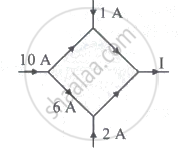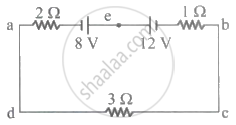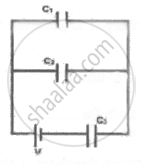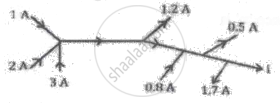Advertisements
Advertisements
Question
State Kirchhoff’s first (current) law.
Solution
The algebraic sum of the currents at a junction is zero in an electrical network.
i.e., `sum_("i" = 1)^"n" "I"_"i" = 0`
where Ii is the current in the ith conductor at a junction having n conductors.
APPEARS IN
RELATED QUESTIONS
Are Kirchhoff’s laws applicable to both AC and DC currents?
Two cells of emf 1.5 Volt and 2 Volt having respective internal resistances of 1 Ω and 2 Ω are connected in parallel so as to send current in the same direction through an external resistance of 5 Ω. Find the current through the external resistance.
Kirchhoff’s second law (voltage law) is based on ______
State Kirchhoff’s second (voltage) law.
What is the basis of Kirchhoff’s current law and voltage law?
Are Kirchhoff’s laws applicable to both AC and DC circuits?
The figure shows a network of currents. The magnitude of currents is shown here. The current I will be ______

The magnitude and direction of the current in the circuit shown will be ______

The potential difference (VA - VB) between the points A and B in the given figure is ______.

What determines the conventional direction of the product of current and resistance while applying the Kirchhoff's law?
In the figure shown, the voltage across C3 will be

In the following electrical network, the value of 'I' is

The current I3 in the following circuit is ____________.

According the Kirchhoff's law, in any analytic circuit, if the direction of current is assumed opposite, then the value of current will be ____________.
Kirchhoff's law of radiation proves that ______
Using Kirchhoff's law, find the current flowing through the given circuit.

Two cells of emf 4 V and 2 V having a respective internal resistance of 1 Ω and 2 Ω are connected in parallel, so as to send current in the same direction through an external resistance of 5 Ω. Find the current through the external resistance.
State Kirchhoff's voltage law.
State sign convention of Kirchhoff's voltage law.
State Kirchhoff's current law sign conventions
The figure shows part of an electric circuit. The potential difference VA - VB is ______.

